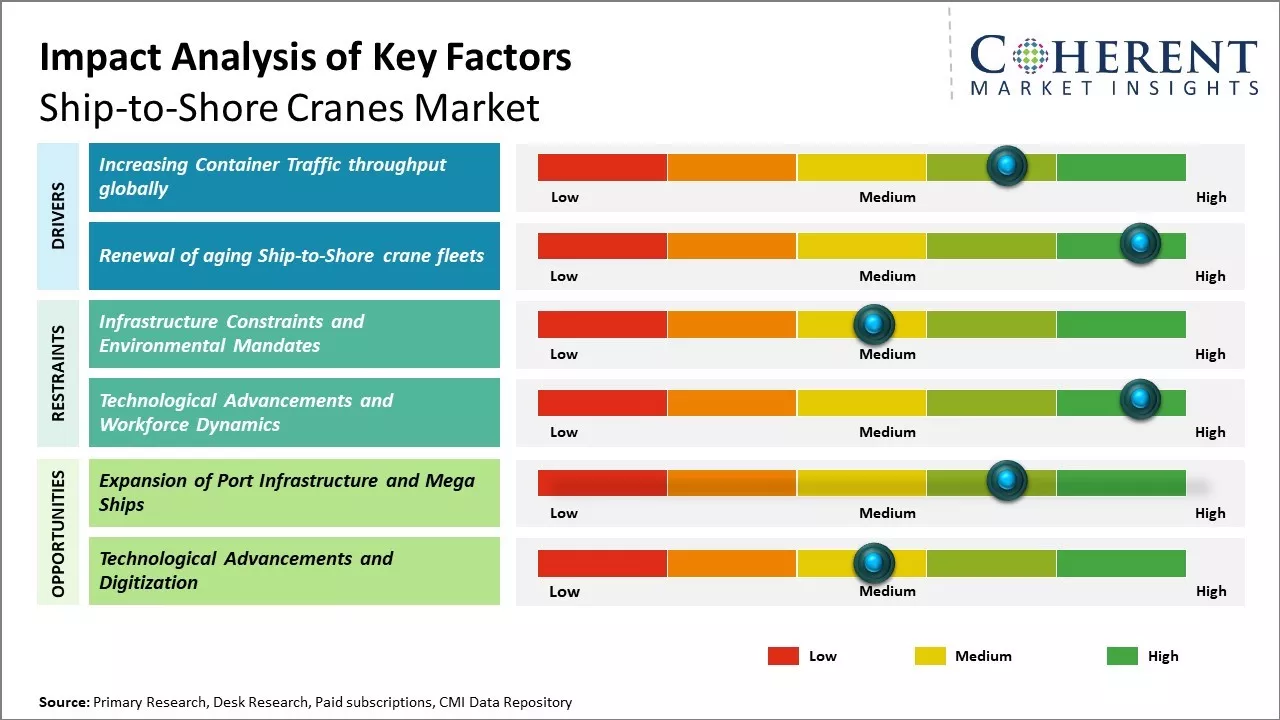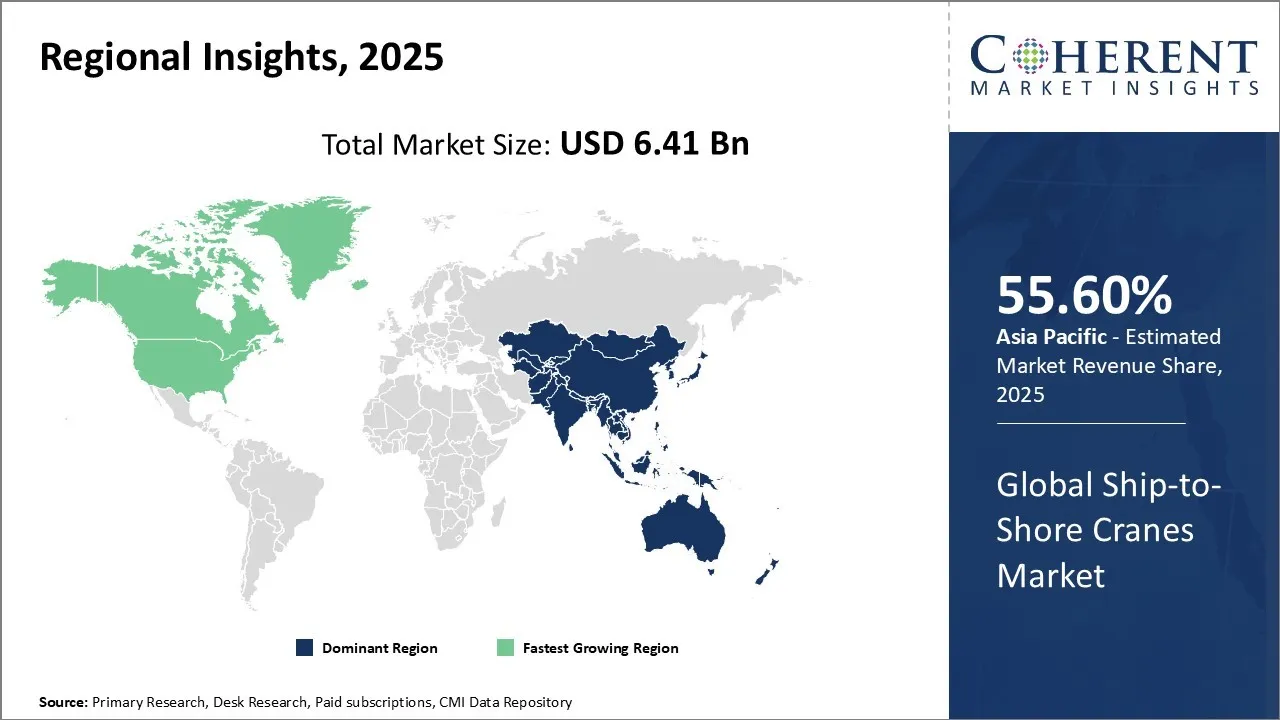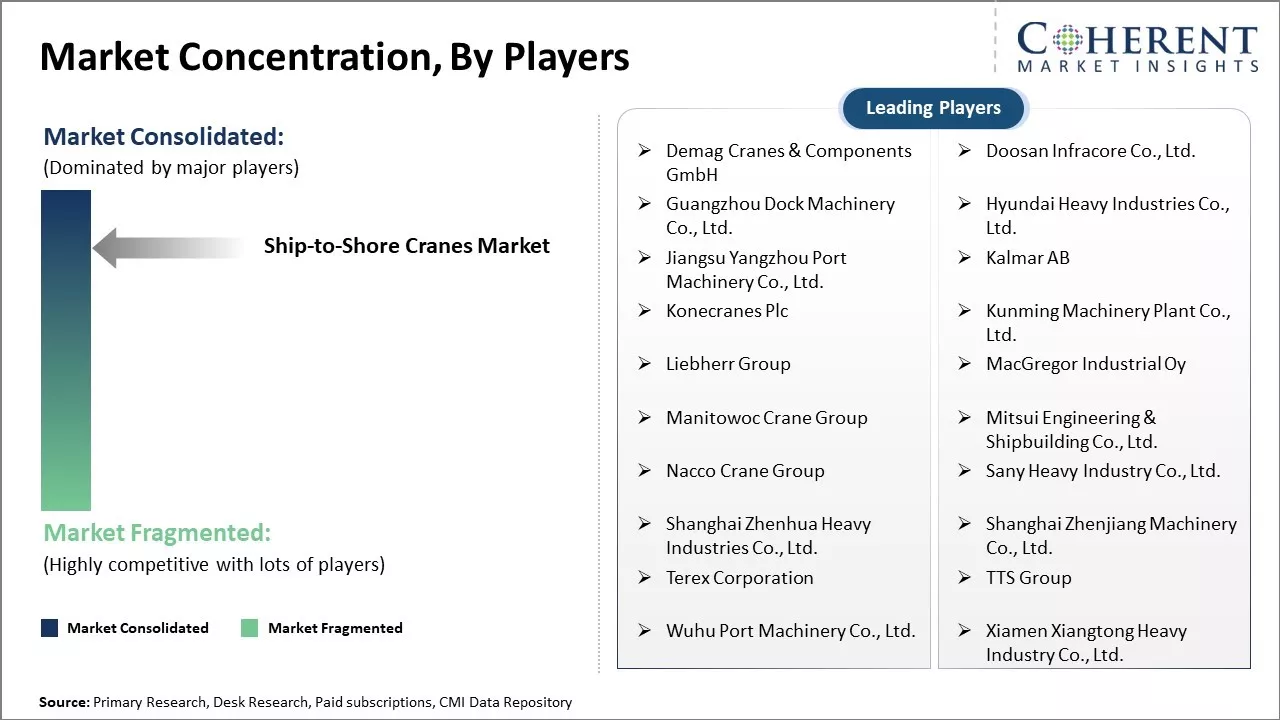The Ship-to-Shore Cranes Market is estimated to be valued at USD 6.41 Bn in 2025 and is expected to reach USD 8.72 Bn by 2032, exhibiting a compound annual growth rate (CAGR) of 4.5% from 2025 to 2032.

To learn more about this report, Download Free Sample
Ship-to-shore cranes are essential for handling cargo at ports efficiently and their widespread use is driving revenues in this market. Growing marine trade activities and capacity expansion of ports to handle increasing cargo volumes will further aid the growth of this market during the forecast period. The market is witnessing a rising demand for technologically advanced ship-to-shore cranes that improve operational efficiency. The adoption of automation, digitization, and remote monitoring solutions in cranes enables higher productivity and reduces maintenance downtime. Manufacturers are extensively investing in R&D to develop autonomous and electric cranes. Such trends towards smart ports are creating new revenue opportunities for ship-to-shore crane providers in the coming years.
|
Current Events |
Description and its impact |
|
Geopolitical Tensions |
|
|
Labor & Automation Shifts |
|
|
Infrastructure Expansion |
|
Uncover macros and micros vetted on 75+ parameters: Get instant access to report
STS cranes generally cost anywhere between USD 6 million and over USD 20 million per unit. Panamax cranes, which are smaller and used for ships passing through the original Panama Canal dimensions, are typically priced between USD 6 million and USD 9 million. Post-Panamax cranes, which support medium-sized container ships, usually cost in the range of USD 8 million to USD 12 million. Super Post-Panamax cranes, which handle very large ships, often fall between USD 12 million and USD 15 million. The most advanced cranes Ultra-Large STS cranes designed for ultra-large container vessels can exceed USD 20 million depending on configuration and technology integration.
The Panamax STS Cranes segment is estimated to hold the highest share of 48.8% in 2025. Panamax cranes are designed to serve mid-sized cargo vessels that can pass through the original Panama Canal locks. As global trade volumes continue rising, many countries are investing heavily in expanding and modernizing port facilities to accommodate larger ship traffic. This involves deepening shipping containers, increasing quay lengths, and installing new gantry rails and yard spaces. Panamax cranes play a vital role in efficiently unloading vessel cargo at such ports. Their lifting capacities ranging from 30-50 tons suit the load requirements of bulk and container ships plying international routes. For instance, in November 2022, DP World installed two Super Post Panamax STS cranes at its terminal in Lirquén, Chile. Powered by renewable energy, the new cranes will enhance the company’s operational efficiency, reduce its carbon footprint by 11%, and boost port productivity by 30%. This is further accelerating the ship to shore cranes market demand.
The >60 meters segment is estimated to hold the highest share of 26.8% in 2025. Advanced STS cranes with extendable booms exceeding 60 meters provide port operators maximum flexibility to serve a wide range of vessel sizes calling at a terminal. The extendable design allows cranes to match their outreach according to vessel types, ranging from small feeders to very large container ships. It enables ports to minimize infrastructure duplication and costs associated with procuring and maintaining multiple fixed-length cranes. The extendable feature also facilitates efficient yard operations as a single crane can service multiple berths. Leading global suppliers have pioneered hydraulic extendable boom technologies that extend outreach by up to 30% without compromising on lifting capacities. This has boosted popularity of extra-long reach STS cranes optimizing versatility at ports. For instance, Liebherr Container Cranes has delivered a ship-to-shore (STS) container crane to Terminales Maritimas Del Sureste S.A. (TMS) at the Port of Alicante, Spain. The crane features a single lift spreader with a 46.9-meter outreach, a 15.24-meter span, a 36-meter lift height, and a safe working load (SWL) of 50 tons.
The Diesel segment is estimated to hold the highest share of 63.8% in 2025. Diesel remains a widely preferred power option for STS cranes operating at ports globally. Powering gantry cranes directly using diesel generators eliminates infrastructure needs for extensive cabling networks to supply electricity from an offsite substation. It provides ports energy security without dependencies on grid power supply. Moreover, diesel fuel remains relatively inexpensive vis-à-vis electricity tariffs in several global trade hubs. Given the capital-intensive nature and long lifecycles of STS cranes, low energy operating costs assume greater significance. Diesel engines also offer fuel efficiency and require less maintenance than gas turbines. For instance, in July 2024, Paradip Port carried out its first ship-to-ship transfer of special grade diesel oil at the North Oil Jetty within the Harbour area, transferring the cargo from MV Orkim Fortitude to the empty tanker MV Torm Republican. The port completed this operation as part of the company’s efforts to cut transportation costs while exploring new avenues for operational expansion. This is further accelerating the ship to shore cranes market growth.

To learn more about this report, Download Free Sample
The Asia-Pacific STS crane market dominates the overall market, with a share of 55.6%. Governments are actively investing in smart-port initiatives and infrastructure, driving the adoption of automated and electric STS cranes. Ports are integrating advanced technologies—such as digital twins, IoT, remote operation, and AI analytics—to boost safety, energy efficiency, and throughput. Sustainability regulations further accelerate the shift toward eco-friendly crane solutions across the region. For instance, during the 15th Singapore Maritime Week, the Maritime and Port Authority of Singapore (MPA) has opened the country’s first Maritime Drone Estate (MDE). Located near the anchorages and Marina South Pier, the MDE provides an ideal setting for testing and advancing drone technology for maritime applications such as remote ship inspections and shore-to-ship transfers.
Environmental regulations are driving North American ports to accelerate the shift toward electric and hybrid STS cranes. Ports along the East and West Coasts are actively replacing diesel-powered machines to meet stricter sustainability targets, reduce emissions, and limit noise pollution. At the same time, terminals are equipping STS cranes with IoT sensors, AI analytics, and remote-control features to enhance real-time monitoring, predictive maintenance, and operational oversight—ultimately improving crane uptime and overall terminal efficiency.
In August 2024, Stafford Crane Group manufactured ship-to-shore (STS) container cranes in the United States.
U.S. ports are actively transitioning from diesel to electric and hybrid STS cranes to meet stringent environmental and noise regulations. These eco-friendly alternatives enhance energy efficiency, reduce emissions, and support national sustainability goals and community health. To increase productivity and capacity, port operators are advocating for automation, including semi-automated STS cranes. However, labor unions like the ILA have enforced restrictions, mandating extra staffing per automated unit. Ongoing labor negotiations continue to influence the pace and extent of automation adoption in the U.S. For instance, three massive, brand-new cranes—now the tallest in North America—have become part of the Port of Oakland's skyline in California, USA. Crews constructed each crane over several weeks and completed the third one last week. This is further proliferating the ship to shore cranes market share.
Major European ports, especially Rotterdam and Hamburg, are rapidly deploying automated STS cranes integrated with digital twins, IoT sensors, and AI analytics. These technologies enhance precision, enable predictive maintenance, and improve terminal synchronization, resulting in higher throughput and reduced manual intervention. To meet strict carbon and noise pollution standards, European ports are swiftly replacing diesel STS cranes with electric and hybrid models. Germany leads this transition through its eco-port initiatives, adopting eco-lifts and energy recovery systems. For instance, the Port of Greenock has introduced its new £25 million ship-to-shore cranes, marking a significant investment aimed at enhancing the facility's productivity. This is further accelerating the ship to shore cranes market revenue.

To learn more about this report, Download Free Sample
| Report Coverage | Details | ||
|---|---|---|---|
| Base Year: | 2024 | Market Size in 2025: | USD 6.41 Bn |
| Historical Data for: | 2020 To 2024 | Forecast Period: | 2025 To 2032 |
| Forecast Period 2025 to 2032 CAGR: | 4.5% | 2032 Value Projection: | USD 8.72 Bn |
| Geographies covered: |
|
||
| Segments covered: |
|
||
| Companies covered: |
Demag Cranes & Components GmbH, Doosan Infracore Co., Ltd., Guangzhou Dock Machinery Co., Ltd., Hyundai Heavy Industries Co., Ltd., Jiangsu Yangzhou Port Machinery Co., Ltd., Kalmar AB, Konecranes Plc, Kunming Machinery Plant Co., Ltd., Liebherr Group, MacGregor Industrial Oy, Manitowoc Crane Group, Mitsui Engineering & Shipbuilding Co., Ltd., Nacco Crane Group, Sany Heavy Industry Co., Ltd., Shanghai Zhenhua Heavy Industries Co., Ltd., Shanghai Zhenjiang Machinery Co., Ltd., Terex Corporation, TTS Group, Wuhu Port Machinery Co., Ltd., and Xiamen Xiangtong Heavy Industry Co., Ltd. |
||
| Growth Drivers: |
|
||
| Restraints & Challenges: |
|
||
Uncover macros and micros vetted on 75+ parameters: Get instant access to report
Ports around the world are rapidly replacing diesel-powered STS cranes with electric and hybrid models to comply with stricter environmental regulations and reduce operating costs. This shift is driven by government incentives, rising carbon emission penalties, and growing public demand for greener port operations. To align with long-term sustainability goals, ports are enhancing energy efficiency and reducing noise pollution by adopting electric cranes. Leading ports in Asia, North America, and Europe are actively investing in grid-connected systems and advanced energy recovery technologies.
The adoption of automation in STS cranes is accelerating as ports seek to enhance safety, throughput, and operational efficiency. Automated cranes equipped with AI analytics, IoT sensors, and digital twins allow for real-time monitoring, collision avoidance, and predictive maintenance. Major terminals like Rotterdam and Shanghai now operate semi- and fully-automated STS units, reducing labor reliance and turnaround times. These advancements are critical in addressing labor shortages and improving container handling consistency.
The advent of mega ships necessitates the deployment of larger and more advanced ship-to-shore cranes. Simultaneously, investments in port infrastructure to accommodate these vessels open up significant opportunities for crane manufacturers and service providers. As ports strive to enhance their capacity and efficiency to handle growing trade volumes, the demand for state-of-the-art cranes capable of efficiently unloading cargo from these massive vessels continues to rise.
Share
Share
About Author
Ankur Rai is a Research Consultant with over 5 years of experience in handling consulting and syndicated reports across diverse sectors. He manages consulting and market research projects centered on go-to-market strategy, opportunity analysis, competitive landscape, and market size estimation and forecasting. He also advises clients on identifying and targeting absolute opportunities to penetrate untapped markets.
Missing comfort of reading report in your local language? Find your preferred language :
Transform your Strategy with Exclusive Trending Reports :
Frequently Asked Questions
Joining thousands of companies around the world committed to making the Excellent Business Solutions.
View All Our Clients